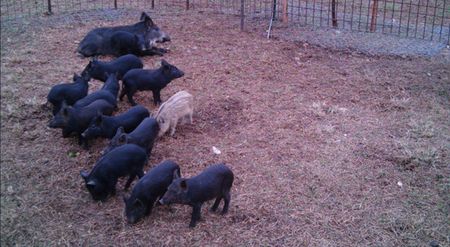Other pages on thise site have discussed the advantages of hog trapping versus hog hunting, but this page is dedicated to giving hog trappers a few tips to help them in the field. Before we go any further, let me first state that in some cases white-tailed deer and other wildlife may become trapped inside hog traps. In the event you capture an unwanted wildlife species, follow these steps for a safe release.
As quickly and quietly as possible, approach the hog trap and secure the trap door fully open and leave immediately. A captured animal can inflict injury to itself out of fright and confusion trying to escape the trap. After the unwanted animal has left, return to the hog trap and reset it. It is also recommended that you approach the trap at night. Non-target animals can be blinded with a hand-held light while the door is opened. Once you leave the area, the animal will exit your hog trap.
Keep scent to a minimum. Hogs have an excellent sense of smell. Try to keep dogs and human activity from near the trap or the trap site. A hog has an acute sense of smell and if it notices unfamiliar scents an unsuccessful trap may result. Odd scents mean no hogs will be captured and valuable time will be wasted.

Feral hogs are mostly nocturnal. Hogs feed at night, so it is best to check the trap first thing each morning. A trap left unattended for a day or two may result in finding a dead hog in your trap. If you can not check the trap each morning, make sure that you place the hog trap in a shaded area and secure a water trough inside the trap. This will allow caught hogs to stay cool, hydrated, and alive until you can check the trap.
Safety first! Be careful when handling the cage with trapped hogs inside. A captured wild or feral hog is a dangerous animal and can attack you through the panel wire. Hogs will often try to escape before you arrive at the trap site, but sometimes the presence of a human is enough to “put hogs over the edge.” This is basically a rush of adrenaline that allows the animal a burst of energy, which could damage the trap and possibly even hurt you in the process. The strength of your hog trap will depend upon the trap design. Just be careful.
Prebaiting is extremely important for successful hog trapping. Remember to prebait with generous amounts of bait or soured grain on a daily basis. In addition, give the hogs several days of entering and exiting the trap prior to setting it. Longer lengths of prebaiting usually result in increased trap success. Feral hogs are smart, so you have to be smarter when it comes to trapping them. Good luck in your efforts to control feral hogs!